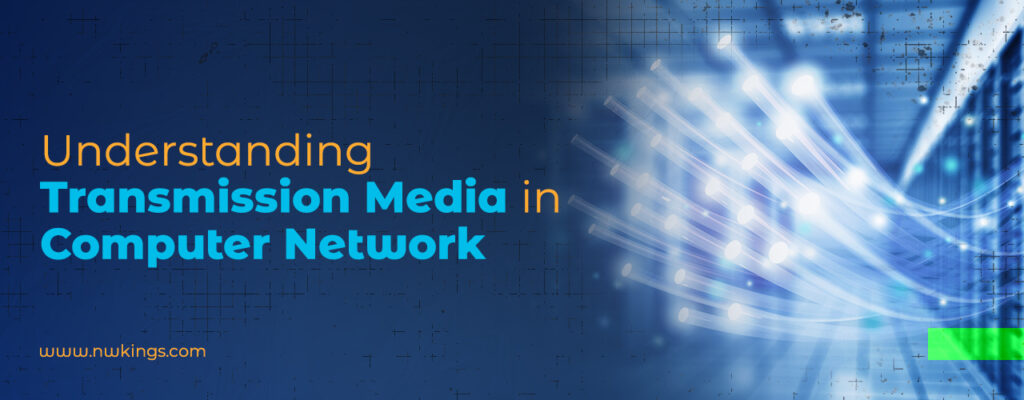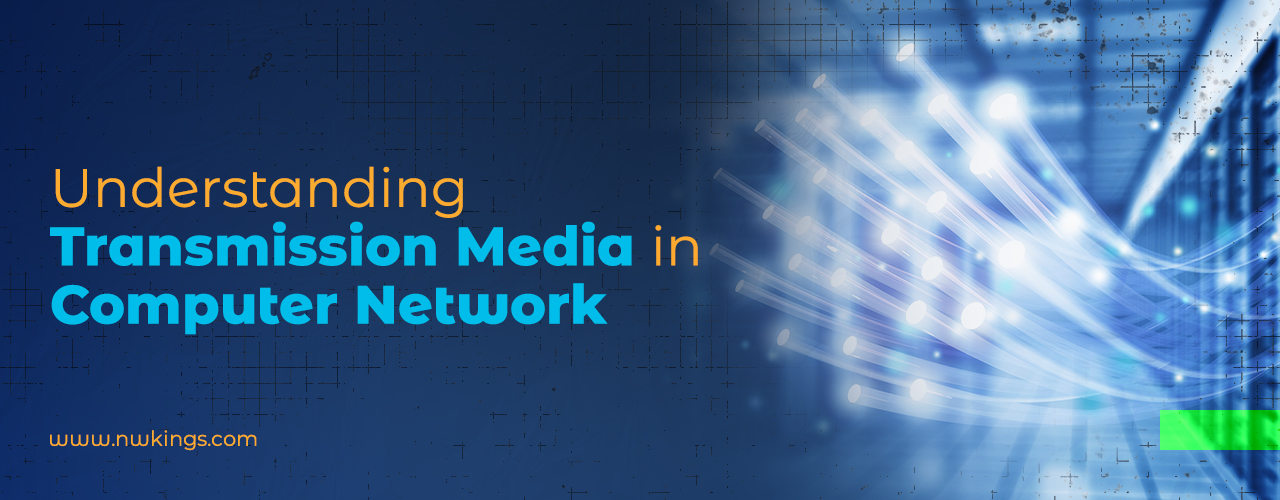
What is Transmission Media?
Transmission media is a medium that carries data from one device to another. It is a physical channel that helps to transmit data from transmitter to receiver. This physical channel can be wired or wireless, where data gets transferred in the form of electromagnetic signals.
NOTE: The primary role of transmission media is to transport information in the form of bits over a Local Area Network.
What are the characteristics of transmission media in Computer Networks?
The following are some of the characteristics of transmission media-
- Bandwidth: Bandwidth is the amount of data transmitted in a given time. Higher bandwidth implies a higher data transfer rate.
- Transmission Distance: It refers to the maximum distance data can travel. Different media have different transmission distances; hence it is a factor to be considered to prevent data loss.
- Interference: The presence of unwanted signals is known as interference. Different media have different levels of tolerance to unwanted signals.
- Cost: Cost also varies depending upon the type of media used.
Transmission media types in Computer Networks: Explained
There are two kinds of transmission media in computer networks:
- Guided
- Unguided Media
Guided and Unguided media are sub-categorized.

What is Guided media in computer networks?
Guided media is a communication medium that uses a physical medium to transmit signals from sender to receiver. It is also referred to as wired media.
What are the types of Guided Media in computer networks?
The kinds of guided media in computer networks are as follows-
Twisted Pair Cable
It consists of two copper wires twisted together to form a single cable which reduces electromagnetic interference. Copper wires are insulated so that both can transmit data simultaneously and eliminates crosstalk.
With the help of twisting, noise and interference also get reduced. Suppose at some point one wire is closer to the noise source while the other is farther, in the next twist reverse happens.
There are two kinds of twisted pair cables:
1. Unshielded Twisted Pair: In this case, the wire has no metallic shield or protection. It is usually used in telephone lines and LAN networks.
Category | Data Rate | Use |
Cat-1 | <.1 Mbps | Old telephone lines |
Cat-2 | 2Mbps | Telephone lines |
Cat-3 | 10Mbps | LAN |
Cat-4 | 16Mbps | LAN |
Cat-5 | 100Mbps | LAN |
Cat-5e | 1Gbps | LAN |
Cat-6 | 10Gbps | LAN |
Advantages of Unshielded Twisted Pair of Cables:
- Cheaper than STP cables
- It is easy to install
Disadvantages of Unshielded Twisted Pair of Cables:
- Vulnerable to electromagnetic interference (EMI).
- It is suitable for short distances due to the problem of attenuation
- Poor performance as compared to STP.
2. Shielded Twisted Pair (STP): In shielded twisted pair cables, wire is provided with an extra metallic covering which provides extra protection from external interference.
Advantages of Shielded Twisted Pair of Cables:
- Less vulnerable to electromagnetic interference (EMI).
- Provides a higher data transmission rate
Disadvantages of Shielded Twisted Pair of Cables:
- Expensive than UTP.
- Due to the extra metallic coating, it is bulky.
NOTE: UTP is used in most Ethernet networks, while STP is used in high-speed networks where interference is a concern.
Coaxial Cable
Coaxial cable is a type of cable that consists of a copper conductor surrounded by a layer of insulation, a braided shield, and then an outer jacket. It is commonly used in cable television networks and broadband internet networks. It can carry signals of higher frequency compared to Twisted Pair cables.
Coaxial cables are divided by their radio government (RG) ratings. RG number denotes the physical specification like the wire gauge of the inner conductor, construction of the shield, type, and thickness of inner insulation. To connect a coaxial cable to the device, we need a connector known as Bayonne-Neill-Concelman (BNe).
Advantages of Coaxial Cable:
- It has higher bandwidth than twisted-pair cables
- Supports transmission rates up to 10gbps
- Less vulnerable to Electromagnetic Interference.
- Have a longer transmission distance.
Disadvantages of Coaxial Cable:
- Coaxial cables are thick and bulky.
- Installation is difficult.
- Expensive
Optical Fiber Cable
Optical fibre is a high-speed transmission medium that uses light to transmit data. It uses the concept of refraction of light. It can transmit data over long distances at high speed and in wide-area networks.
Optical fibre cable consists of the following components:
- Core: It is the central part where light travels. It is made up of glass or plastic fibres.
- Cladding: It surrounds the core and is made up of material with a lower refractive index than the core. The difference in refractive index helps the light to travel along the core by promoting internal reflection.
- Jacket: It is the outer layer and protects the core and cladding. It is made of a durable material like PVC and protects the inner layers from moisture, chemical abrasions, and other physical damage.
Advantages of Optical Fibre Cable:
- It has a much higher bandwidth than copper cables
- It can transmit large amounts of data over much longer distances without using single boosters or repeaters.
- It has low attenuation.
- Lightweight and compact compared to copper cables.
- Immune to electromagnetic interference.
Disadvantages of Optical Fibre Cable:
- Optical Fibre cables are expensive.
- They are fragile as compared to copper cables.
What is Unguided Media in computer networks?
Unguided media is a type of media that uses electromagnetic waves to transmit data from sender to receiver. It uses no physical medium but signals are transmitted through air.
In the case of unguided media, no physical medium is required. Signals are transmitted through the air using radio waves, microwaves, or infrared waves.
For instance – File sharing over Bluetooth and WI-FI connectivity.
What are the types of Unguided Media in computer networks?
The kinds of unguided media in computer networks are as follows-
Radio Waves
Electromagnetic waves ranging between 3KHz to 1GHz are called radio waves. Radio waves are omnidirectional, which means when radio waves get emitted, they propagate in all directions, and hence the sending and receiving antennae need not be aligned and can even penetrate obstacles such as walls.
Radio waves get used in Bluetooth, radio broadcasts, cellular networks, WI-FI, and even satellite communications. Radio waves are prone to interference from devices/antennae operating at the same frequencies which also makes wireless communication vulnerable to unauthorized access.
Microwaves
Electromagnetic waves ranging from 1GHz to 300GHz are called microwaves. Microwaves are unidirectional, and hence sending and the receiving antenna should align. They are used for point-to-point and point-to-multipoint communications.
Since the antenna needs to be aligned, towers (equipped with antennae) that are at a distance need to be tall, or else the curvature of the earth and tall buildings do not allow the antennae to communicate. Hence, the infrastructure is quite expensive.
NOTE: Microwaves with high frequency cannot penetrate walls.
Infrared
Electromagnetic waves ranging from 300GHz to 400THz are called infrared. Since they have short wavelengths and high frequency, they cannot penetrate objects or walls. Hence, they are suitable for short-distance communications. Also, infrared waves are not suitable for outside usage because sun rays also contain infrared which can lead to interfering communication.
NOTE: Infrared get used in remote controls.


